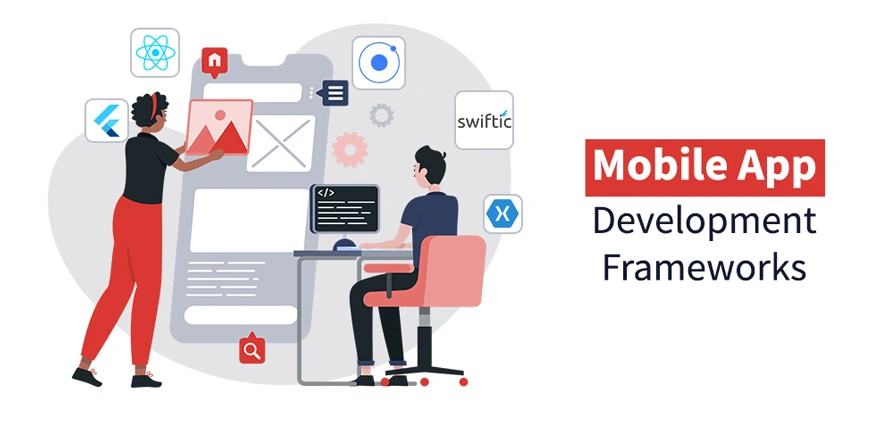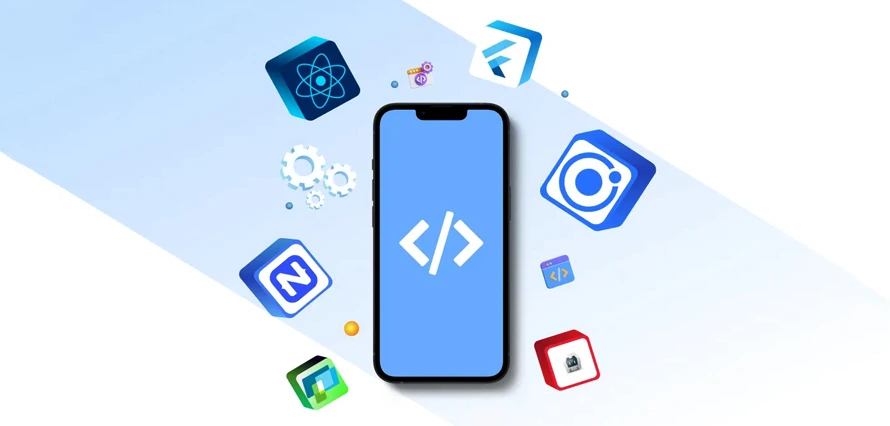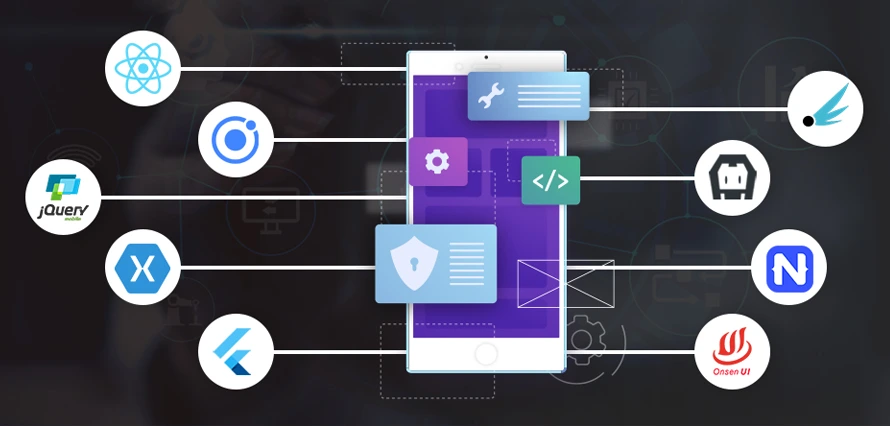Table of Contents
In 2025, mobile applications are not just a trend—they are an essential part of modern life. From daily banking to fitness tracking and remote work to e-commerce, mobile apps serve as the digital gateway to almost everything.
With over 4 million apps across the Google Play Store and Apple App Store and thousands more launched every day, businesses and developers face a crucial question:
“Which mobile app development framework should I use?”
In this blog, we’ll explore the best mobile app development frameworks in 2025, how they work, what makes them unique, and how to choose the right one for your needs. Whether you’re a CTO, entrepreneur, or mobile developer, this guide is packed with insights and actionable information.
What is a Mobile App Development Framework?

A mobile app development framework is a pre-built platform that provides a structured foundation for developing apps across iOS, Android, and other operating systems. These frameworks come packed with tools like compilers, libraries, debuggers, and APIs that streamline the development lifecycle.
Using a framework allows developers to:
- Write less code and reuse components
- Build cross-platform or hybrid apps
- Ensure faster time-to-market
- Reduce costs with shared codebases
Classification of Mobile App Frameworks

Understanding the types of mobile frameworks is essential before making your choice:
- Native App Frameworks – Built for specific OS like Android or iOS.
- Web App Frameworks – Run on web browsers using HTML/CSS/JS.
- Hybrid App Frameworks – A Blend of native and web apps.
You can also categorize frameworks by architecture:
- High-Level Full-Stack Frameworks
- Low/No-Code Frameworks
- Code Generators & Aggregators
- Narrow-Focused Frameworks
- High-Level Coding Language Approaches
Top 10 Mobile App Development Frameworks in 2025

Here’s a detailed overview of the best frameworks based on speed, scalability, flexibility, and real-world usage.
1) Flutter (by Google)
Flutter is one of the most rapidly adopted frameworks for mobile app development in recent years. Created by Google, Flutter allows developers to build beautiful, fast, and natively compiled apps for mobile, desktop, and web—all from a single codebase.
Features:
- Hot Reload for instant visual updates.
- Rich widget library with Material Design support.
- Uses the Skia engine for smooth 2D rendering.
- Strong support for animations, transitions, and UI customization.
Ideal For:
- MVPs, startups, large-scale apps.
- High-performance apps with custom UIs.
Famous Apps Built With Flutter:
Alibaba, Google Pay, BMW, eBay, Reflectly
2) React Native (by Meta/Facebook)
React Native enables developers to use React + JavaScript to build truly native apps across platforms. Its strong ecosystem and developer community make it a powerful contender in 2025.
Features:
- Fast Refresh for immediate feedback.
- Renders use native components to ensure a real look and feel.
- Integrates with native modules and third-party plugins.
- Strong community support and ecosystem.
Ideal For:
- Projects needing a large community and plugin ecosystem.
- Teams already proficient in JavaScript.
Top Apps Using React Native:
Instagram, Facebook, Walmart, Tesla, Airbnb
3) Kotlin Multiplatform (JetBrains)
Kotlin Multiplatform, developed by JetBrains, lets you reuse logic across platforms (Android, iOS, web, desktop), with the ability to write platform-specific code when needed. As of November 2023, KMP is officially stable.
Features:
- Reuse business logic and APIs.
- Seamless native integration for Android/iOS.
- Compatible with Compose Multiplatform UI.
- Ideal for large projects with Kotlin expertise.
Ideal For:
- Android teams looking to expand to iOS.
- Enterprise-grade applications requiring native performance.
Used By:
Netflix, McDonald’s, Philips, Cash App
4) Ionic Framework
Ionic is perfect for building hybrid mobile apps and progressive web apps (PWAs) using standard web technologies. It works well with Angular, Vue, and React.
Features:
- Cordova/Capacitor plugins are used to access native features.
- High-quality UI components.
- Support for PWAs and native packaging.
- Ionic CLI for streamlined development.
Ideal For:
- Web developers building mobile apps.
- Cross-platform projects with tight deadlines.
Top Apps:
T-Mobile, Sworkit, JustWatch, Diesel, MarketWatch
5) .NET MAUI (Microsoft)
.NET MAUI is the successor to Xamarin. Forms and part of the broader .NET ecosystem. It’s Microsoft’s go-to framework for building native apps across Android, iOS, macOS, and Windows.
Features:
- Unified codebase for all platforms.
- Integrated development in Visual Studio.
- .NET Hot Reload for live updates.
- Access to device APIs through .NET libraries.
Ideal For:
- Enterprises and teams already using Microsoft tech stack.
- Desktop and mobile app hybrid projects.
Used In:
NBC Sports Next, Escola Ágil, Irth Solutions
6) NativeScript
NativeScript enables native API access with zero WebViews, resulting in better performance and a truly native feel.
Features:
- Direct API access for iOS and Android.
- Native UI rendering without WebViews.
- Rich plugin ecosystem.
- Support for modern JavaScript frameworks.
Ideal For:
- Projects needing native-level performance with web tech.
- Teams with Angular or Vue experience.
Built Apps:
Daily Nanny, Strudel, BitPoints Wallet
7) Xamarin
Xamarin lets you build native apps using C# with full access to device APIs and performance optimization.
Features:
- Shared codebase using .NET.
- Native UI performance.
- Xamarin.Forms for UI development.
- Active support from Microsoft.
Ideal For:
- Apps requiring platform-specific features.
- Developers with C# expertise.
Top Projects:
FreshDirect, The World Bank, APX
8) Swiftic
Swiftic is a DIY app builder targeted at small businesses and non-coders. It offers templates and drag-and-drop features for creating iOS apps quickly.
Features:
- In-app promotions and loyalty programs.
- Simple dashboard and builder.
- Multiple business-specific tools.
- Money-back guarantee if not satisfied.
Ideal For:
- Small businesses with no coding background.
- Entrepreneurs launching local business apps.
Apps Created:
Spa Cafe, Remix Coffee Co., Mt. Royal Bagel Co.
9) Apache Cordova
Apache Cordova, formerly known as PhoneGap, wraps web apps into native shells to deploy across platforms.
Features:
- Access device APIs via plugins.
- Unified development using web code.
- Lightweight and fast for MVPs.
Ideal For:
- Lightweight hybrid apps.
- Developers familiar with web technologies.
10) Sencha Ext JS
Sencha Ext JS is best suited for data-intensive applications, especially in enterprise environments.
Features:
- 115+ UI components.
- D3 integration for data visualization.
- Pre-built templates and themes.
- High-performance grids and charts.
Ideal For:
- Enterprise dashboards and CRMs.
- Complex data-driven UIs.
Conclusion
In 2025, building a successful app means more than just having a great idea—it means choosing the best mobile app development framework that balances performance, cost, and scalability. Whether you’re building a complex enterprise application or a sleek consumer app, one of these top 10 mobile app frameworks will help you deliver an exceptional user experience.
Stay ahead of the curve—select a framework that empowers your team, meets your business needs, and sets the foundation for a scalable mobile future.







